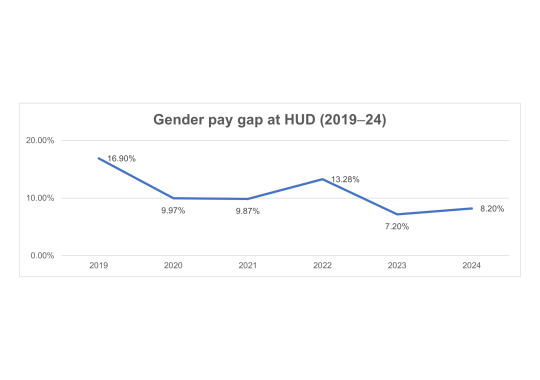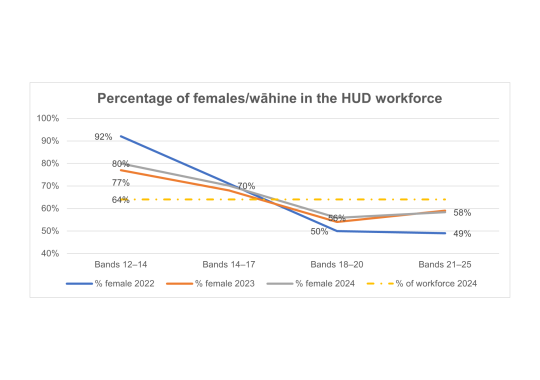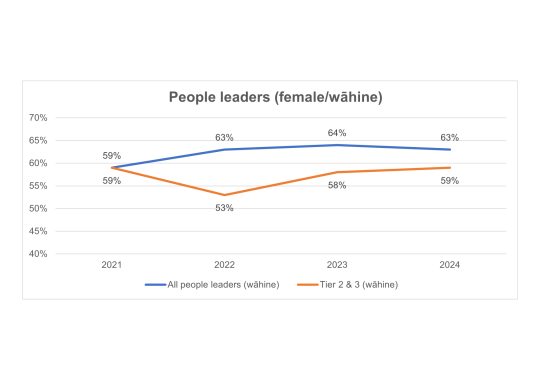Diversity, equity and inclusion workplan
On this page you will find information about how Te Tūāpapa Kura Kāinga is approaching diversity, equity and inclusion in the workplace. Past pay gap action plans are also available on this page.
Introduction
Te Tūāpapa Kura Kāinga – Ministry of Housing and Urban Development (HUD) plays a lead role in helping individuals, family and whānau have healthy, secure and affordable homes that meet their needs. Our purpose is he kāinga ora, he hapori ora – thriving communities where everyone has a place to call home.
We are committed to building a diverse and inclusive organisation, where our people feel part of a thriving community centred around our HUD whānau, and where our workforce has the diversity to enable us to respond to the housing challenges faced by New Zealand.
Our diversity, equity and inclusion workplan builds on the actions we have taken since 2019 to reduce pay gaps and continue to build an inclusive workplace that reflects and embraces diversity. The workplan is guided by the Papa Pounamu Public Service work programme and Kia Toipoto – the Public Service Pay Gaps Action Plan 2021–24, which together set the direction for diversity, equity and inclusion work across the Public Service.
Setting the scene: a strategic approach to diversity, equity and inclusion
As part of our diversity and inclusion strategic approach we developed three long-term goals to guide our practice:
- our workforce reflects our kaupapa.
- our people feel a sense of belonging, led through our leadership practices.
- our people are valued for their ideas and contributions; diversity of thought guides our practice.
Our diversity, equity and inclusion workplan guides our progress towards these goals.
This report and action plan is aligned with the Public Service Commission's pay gaps and pay equity(external link)
Download a copy of the diversity, equity and inclusion workplan 2024/25
Our progress
Our achievements in 2023/24:
- Our overall gender balance has remained steady during a period of change, and we have maintained the high percentage of females/wāhine in people leader roles.
- Increased our cultural competence learning offerings, particularly those to support Māori/Crown relations, te reo Māori and tikanga. We maintained our focus on building ways of working that reflect and support a te ao Māori worldview.
- Maintained diversity of our workforce including a high percentage of Māori employees. Māori make up 22 percent of our workforce, and 21 percent of our people leader roles. This reflects our focus on strengthening our Māori capability and ensuring we have capability and capacity to boost housing and urban development outcomes for Māori.
- Continued application of good recruitment practices, including publishing the salary range in our job adverts to provide transparency to potential candidates.
- Continued commitment to the Pride Pledge; some of our people have attended their rainbow awareness training.
- Participation in programmes that support diversity of the public sector workforce, including hosting three interns from the Tupu Tai Pasifika Public Sector Summer Internship Programme.
- Regular pulse surveys to monitor the experiences of our people.
Gender representation and pay gaps
As at 30 June 2024, we had 359 permanent or fixed-term employees who had provided gender information – 64 percent female/wāhine and 36 percent male/tāne.
Our gender pay gap is 8.2 percent, up from 7.2 percent in 2023.
When we were established in 2018, we inherited a pay gap which we have taken deliberate action to address. As a small Ministry our pay gaps can fluctuate year on year, but overall, our gender pay gap has remained well below where it began.

Drivers of our gender pay gap
Our gender pay gap is because there is a higher percentage of females/wāhine in our lower and mid-level roles. Figure 2 shows how the percentage of females/wāhine in our workforce has changed since 2022. Over the last 12 months there has been a slight decrease in the percentage of females in our higher pay bands, and a slight increase in the percentage in our lower pay bands. As a result of these changes our gender pay gap has increased by one percent.

When we look within our pay bands, we have mostly closed pay gaps for same or substantially similar roles. We are confident we are paying females/wāhine and males/tāne equitably for the same or substantially similar work.
Gender representation of people leader roles
Figure 3 shows that we have maintained the high percentage of in people leader roles. Females make up 63 percent of people leader roles, and 59 percent of tier 2 and 3 positions.

Eighty-eight percent of our people have provided ethnicity information. Recording demographic information will remain a focus to enable accurate reporting.
The ethnic make up of our organisation does not currently fully reflect the ethnic diversity of the communities we serve. We are broadly representative of the New Zealand population for Māori, New Zealand European, Asian, Middle Eastern/Latin American/African (MELAA) and Other ethnicities, but we are under-represented in Pacific peoples.
-
Ethnic make-up of our workforce at 30 June 2024
Ethnicity % staff % leader % total NZ population New Zealand European 72% 85% 75% 68% Māori 22% 21% 22% 18% Asian 15% 3% 13% 17% Pacific Peoples 4% 3% 4% 9% MELAA 2% 0% 2% 2% Other 4% 0% 4% 1% -
Average salary by ethnic group
The average salaries for our different ethnic groups are detailed below.
Ethnicity Average salary New Zealand European $136,719 New Zealand European male $143,964 New Zealand European female $133,453 Māori $132,315 Māori male $141,075 Māori female $129,250 Asian $110,292 Pacific Peoples, MELAA, other ethnicities $112,960
We have enough people in some ethnic groups to report pay gaps, but not in others. Māori and Asian pay gaps are reported below. For other groups the numbers are too small to enable accurate reporting of pay gaps, so we have combined them as shown in Figure 4.

Our ethnic pay gaps
Māori pay gap
The pay gap for our Māori staff is 1.8 percent. Māori make up 22 percent of our total workforce, higher than the wider public sector, and 21 percent of our people leadership roles. This reflects our continued focus on strengthening our Māori capability, particularly at senior levels.
Asian pay gap
The pay gap for our Asian staff has increased, up from 15.7 percent to 19.47 percent. Thirteen percent of our staff identify as Asian. This pay gap is a result of a higher percentage of our Asian workforce in certain business groups and occupations, and lower numbers of Asian staff in senior positions.
Other ethnic pay gaps
The number of Pacific Peoples, MELAA and other ethnicities in our workforce are too small to report individually this year. The combined pay gap for this group is 14.88 percent.
Disability and rainbow communities
Our pool of employees with a disability is too small (0.3 percent of our workforce) to provide pay gap data. We do not collect information about the percentage of our workforce who identify as being a member of the rainbow communities.
Our workplan for 2024/25
The PSA were engaged in the development of our workplan for 2024/25.
-
Diversity
Actions to date
Planned actions for July 2024–June 2025 - Policies to ensure language is gender neutral were reviewed.
- Pacific language weeks were celebrated.
- Gender balance was maintained through recruitment and selection.
- We increased the percentage of our people recording demographic information.
- We participated in targeted development programmes (for example, rangatahi Māori emerging leaders programme).
Summary
Our continued workforce representation challenges are:
- how we increase the number of Pacific peoples in our workforce
- how we increase the ethnic diversity of our people leaders.
The small amount of recruitment in 2024/25 is likely to be small, so we have not set any targets to address our representation challenges. We are focused on maintaining our diversity through 2024/25, while looking for opportunities to address these challenges.
Planned actions
- Promote collection of demographic information to maintain an accurate picture of our workforce diversity.
- Regular reporting on our demographic profile to the organisational health committee.
- Update our recruitment guidance for leaders to include bias awareness.
- Continue to use the lead toolkit when reviewing people policies and/or guidelines.
- Look for opportunities during recruitment and selection processes to increase the number of Pacific peoples in our workforce, and the ethnic diversity of our leadership cohort.
What success looks like
Our workforce gender and ethnic diversity is maintained through 2024/25.
-
Equity
Actions to date
Planned actions for July–June 2025 - Policies to ensure language is gender neutral were reviewed.
- Pacific language weeks were celebrated.
- Gender balance was maintained through recruitment and selection.
- We increased the percentage of our people recording demographic information.
- We participated in targeted development programmes (for example, rangatahi Māori emerging leaders programme).
Summary
Our remuneration, recruitment and learning and development practices are focused on making consistent and fair decisions. We will continue to monitor our practices.
Planned actions
- Reviews of appointments (demographics of appointees) and associated salaries will continue.
- All policy reviews will continue to have a diversity, equity and inclusion lens applied (for example, using the ‘Lead Toolkit’ which provides guidance on employing disabled people, as we review our recruitment and accommodation policies and guidance, or considering how the guidance in ‘Yavu’ the Pacific engagement tool can help us connect with potential candidates from Pacific communities).
- Support a diverse and inclusive workplace by making neutral language and inclusive leadership part of role design. We will also monitor the diversity of our workforce during periods of change.
- Continue to ensure there is no bias applied to decision-making during change.
- Maintain our focus on offering a flexible work environment, in line with Public Service Commission guidance and our employment agreements.
What success looks like
There is no evidence of any bias during recruitment and appointment, including starting salaries, and there is no increase in our pay gaps year-on-year.
-
Inclusion
Actions planned to date
Planned actions for July 2024–June 2025 - Built cultural capability through the ongoing implementation of our Whāinga Amorangi organisational plan, and Tuakea, our Māori language plan.
- Embedded a strong te ao Māori worldview into our workplace culture, including the use of karakia, mihi whakatau and waiata.
- Introduced our approach and tools to support flexible working.
- Rolled out rainbow e-learning module and Pride Pledge rainbow awareness training.
- Continue to celebrate our workforce with stories about our people that reflect our diversity.
- Put in place our protected disclosure and speak-up policies.
- Revamped our induction approach and embedded cultural capability learning and bias awareness learning into induction.
- Six People’s Networks were established: Wāhine Toa, Wāhine Āhuru (women’s network), Rainbow Network, Whakatipu Mauriora (mental health network), waiata group, Green Group (environmental).
- Leadership development offerings had a diversity, equity and inclusion focus.
- We developed toolkits for leaders to support them to build their capability and apply good management practices, for example, effective coaching.
Summary
The responses to our regular pulse surveys enable us to continue to monitor the experiences of our people. Our focus for 2024/25 is to promote good practice and ensure our workplace is inclusive for our people.
Planned actions
- Our People’s Networks will be supported to lead initiatives and identify areas where they can input into our policies and practices. Network leads will be supported and recognised for their contribution to our workplace.
- Continue to celebrate events that celebrate diversity and inclusion, for example, Matariki, Te Wiki o te Reo Māori, Pacific language weeks and Pride Week.
- Our leaders will be supported to embed good people leadership practices, including regular one-on-one conversations and performance and development.
- Leadership Development Centre programmes to learn about inclusive leadership will be promoted.
- We will promote inclusive leadership and bias awareness learning to our leaders.
- Through our Whāinga Amorangi workplan and our Māori Language Plan, we will continue to embed te ao Māori within our workplace.
What success looks like
We see improvement in our regular pulse survey questions: Leadership: Te ārahi tangata I te mahi, and How I feel: Taku āhua I te mahi.